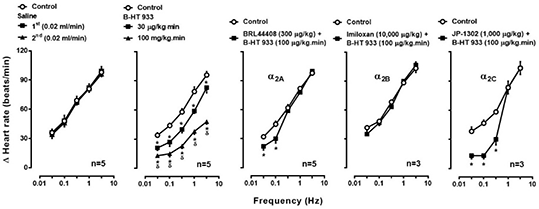Print version
Search Pub Med
| 080P London, UK Pharmacology 2016 |
Pharmacological evidence that alpha2A-, alpha2B- and alpha2C-adrenoceptor subtypes inhibit the cardioaccelerator sympathetic outflow in diabetic pithed rats
Introduction: The pharmacological profile of the alpha2-adrenoceptors inhibiting the vasopressor sympathetic outflow is altered in diabetes mellitus1. This comprises abnormalities in the central and peripheral catecholaminergic systems2. Since B-HT933-induced inhibition of the cardioaccelerator sympathetic outflow in normoglycemic pithed rats involves activation of alpha2A- and alpha2C-, but not alpha2B-adrenoceptor subtypes3, we investigated the pharmacological profile of B-HT933-induced inhibition of the cardioaccelerator sympathetic outflow in diabetic pithed rats.
Method: Eighty six male Wistar rats (280-300 g) were pretreated with streptozotocin (50 mg/kg, i.p.; n=66) or vehicle (1 ml/kg citrate buffer, i.p.; n=20) and kept for 4 weeks. After pentobarbital anaesthesia (60 mg/kg; i.p.) the animals were pithed, artificially ventilated with room air (56 strokes/min, stroke volume: 20 ml/kg), and prepared for selective preganglionic spinal stimulation (C7-T1; 0.03-3 Hz; 50 V; 2 ms pulses) of the cardioaccelerator sympathetic outflow; or i.v. bolus of noradrenaline (0.03-3 µg/kg). The carotid artery was cannulated for measurement of blood pressure and heart rate. Before electrical stimulation, all animals received i.v. gallamine (25 mg/kg; to avoid muscular twitching) and desipramine (50 µg/kg; to amplify the sympatho-inhibition at lower stimulation frequencies)3. Body temperature was kept at 37°C. Data analysis included 2-way repeated-measures ANOVA+Student-Newman-Keuls test. Statistical significance (*) was accepted at P<0.05. Our institutional ethics committee approved our experiments (protocol number 0139-15).
Results: Electrical stimulation and i.v. bolus of noradrenaline in normoglycemic and diabetic pithed rats produced frequency-dependent and dose-dependent tachycardic responses, respectively (not shown). These responses in diabetic rats were: (i) unchanged during i.v. infusions of 0.02 ml/min saline; and (ii) dose-dependently inhibited during i.v. infusions of 30 and 100 µg/kg.min B-HT933 (Fig. 1). Furthermore, the cardiac sympatho-inhibition by 100 µg/kg.min B-HT933 in diabetic rats, which did not affect the tachycardic responses to noradrenaline (not shown) was: (i) unchanged after vehicles (not shown); and (ii) abolished after i.v. administration of the antagonists BRL44408 (alpha2A; 300 µg/kg), imiloxan (alpha2B; 10,000 µg/kg) or JP-1302 (alpha2C; 1,000 µg/kg) (Fig. 1). The doses of these antagonists, which had no effect per se (P>0.05) on the sympathetically-induced tachycardic responses, were enough to completely block their respective receptors in pithed rats3.
Conclusion: Unlike in normoglycemic rats, B-HT933-induced cardiac sympatho-inhibition in diabetic pithed rats involves activation of alpha2A-, alpha2B- and alpha2C-adrenoceptor subtypes.
References:
1. Altamirano-Espinoza AH et al. (2015). Basic Clin Pharmacol Toxicol 117: 31-38.
2. Gallego M et al. (2003). Physiol Res 52: 735-741.
3. Cobos-Puc LE et al. (2007). Eur J Pharmacol 554: 205-211.

Fig. 1. Effect of antagonists on B-HT 933-induced cardiac sympatho-inhibition in diabetic pithed rats.
δP<0.05 vs 30 µg/kg.min B-HT 933.

